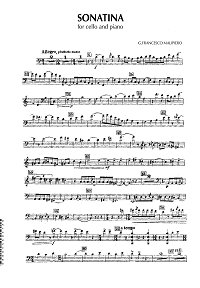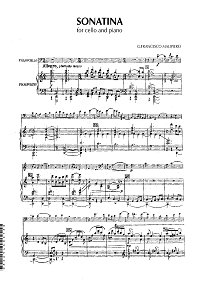Malipiero - Sonatina for cello and piano
Malipiero - Sonatina for cello and piano. You can download the PDF sheet music Malipiero - Sonatina for cello and piano on this page. The sonority of a solo cello does not blend with the piano, it does not allow the discourse to become a single expression; the two instruments raise their voices to contradict one another. These observations may be clearly visible in this Sonatina for cello and piano, written in 1943 and therefore slimmer and apparently more spontaneous. This Sonatina is in three movements but they are played without interruption: the central section, which is lengthy and slow, is linked to the other two (faster) sections through the use of two chords entrusted to the piano which return, either identically or modified, at certain crucial moments. The atmosphere of this composition, despite the cruelty of the war and the fury of the bombardments, appears to be basically relaxed and at times even joyful.
To download PDF, click the "Download PDF" button below the appropriate sheet music image.
To view the first page of Malipiero - Sonatina for cello and piano click the music sheet image. |
| PDF format sheet music |
|
|
|
Cello part: 3 pages. 2371 K
|
Piano part: 9 pages. 5802 K
|
 |
 |
|
|
| Download PDF (14.99
€) |
Download PDF (14.99
€) |
|
|
|
| Gian Francesco Malipiero was born in Venice on 18 March 1882 into a family with a long musical history. At the young age of eleven, the boy followed his father to Vienna, where he studied for some time at the conservatory. In 1899, he returned to his mother in Venice and enrolled in the Liceo Musicale "Benedetto Marcello" before transferring to the conservatory in Bologna, where he earned a diploma in composition under Marco Enrico Bossi. In 1908, he went on to take some lessons in Berlin with Max Bruch, and in this same period met Ferraccio Busoni. From the very beginning, however, Malpiero disliked and resented the academic conformity of his teachers and the environment in which ne was studying. This attitude explains his enthusiasm for some contemporary composers as well as his precocious interest in the ola masters; the latter would accompany him for his entire life in his activities as scholar, editor and transcriber of Monteverdi, Stradella, Vivaldi, Marcello and Galuppi. A sojourn in Paris in 1913 allowed him to establish relations with artists who influenced his training and style, such as Gabriele D'Annunzio, Claude Debussy and Medardo Rosso. Others who would become longtime friends and acquaintances include Ildebrando Pizzetti, Alfredo Casella and Guido M. Gatti. the period dating from immediately after the First World War up until the eve of the Second World War was a fertile time for Malipiero: these years overlapped with his teaching and were marked as well by a growing international fame. In 1923, he settled in Asolo and remained there until his death in Treviso on 1 August 1973. The author of a vast number of compositions including about forty operas and ballets, eleven symphonies and eleven concertos, numerous pieces for the piano, chamber and vocal works, as well as critical studies, literary writings and memoirs, Gian Francesco Malipiero lived and worked in a difficult and extraordinary balance Between the new and the old. He was unquestionably the most important and complete musician of the Generazione dell'Ottanta, a member of the avant-garde of the first post-war period, and an advocate of an anti-romantic conception of harmony without the residue of nineteenth-century chromaticism. |
|